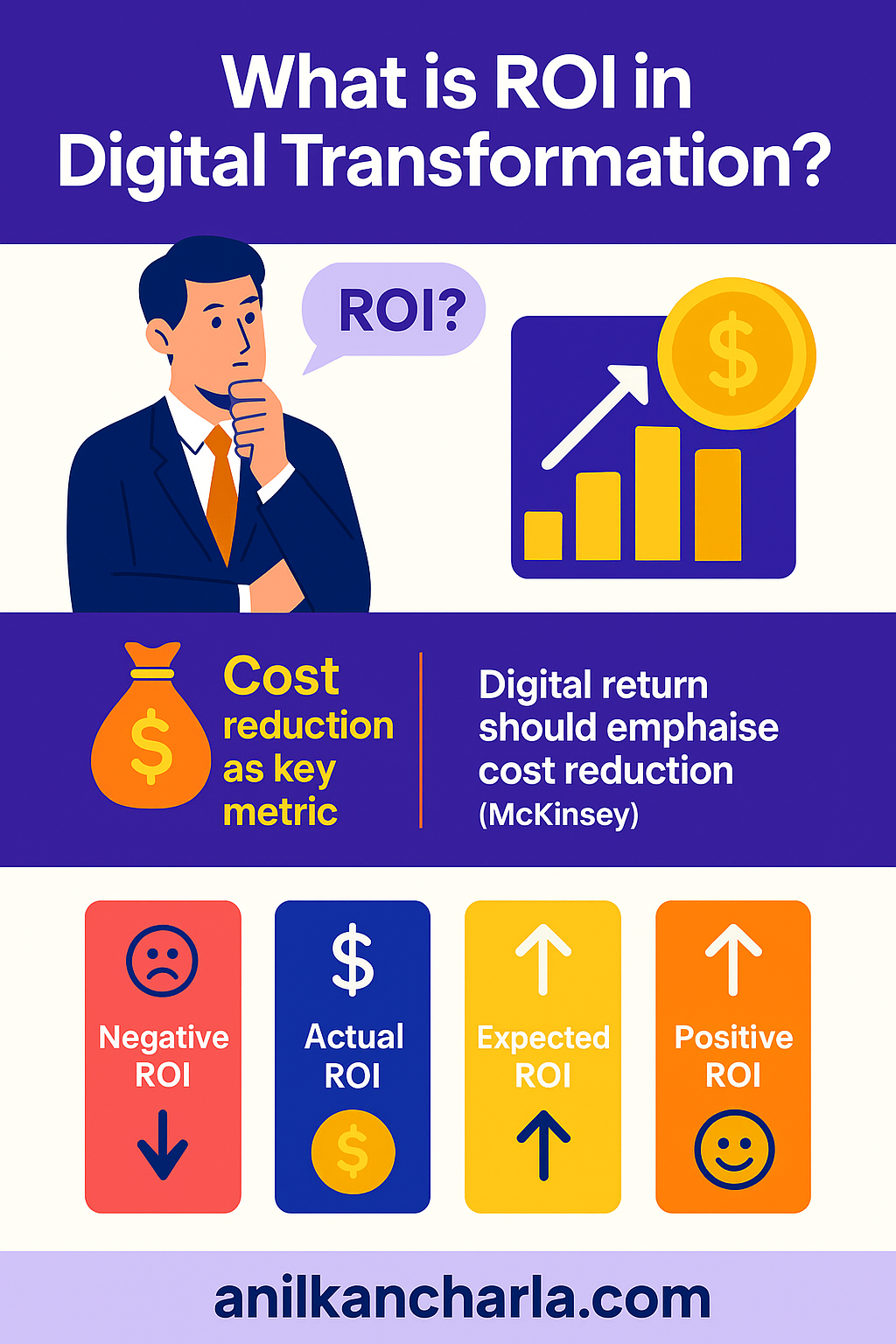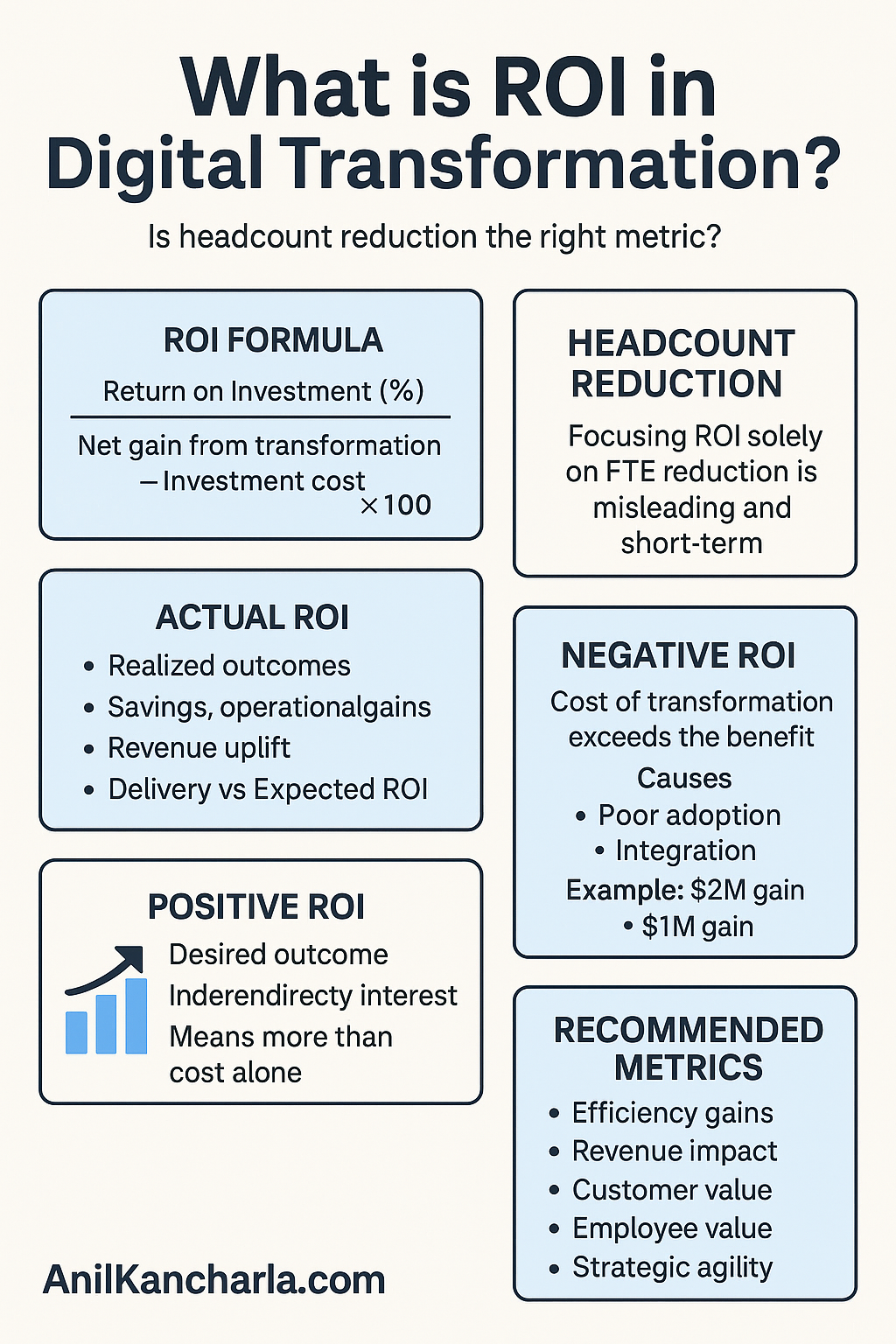What Is ROI in Digital Transformation? How to Measure It, Avoid Pitfalls & Show True Value
2025-05-22 · By Anil Kancharla · 6 min read
❤️ 0 Likes · 👁️ 0 Views

📘 The Real ROI of Digital Transformation: What Executives Should Measure (and What They Shouldn’t)
💡 Introduction: The ROI Dilemma in Digital Transformation
Digital transformation (DT) is no longer optional but necessary. From AI-driven automation to ERP cloud migration, businesses invest millions to modernize operations and stay competitive. However, once the fanfare fades and the implementation challenges begin, one question looms large:
“What is our digital transformation's Return on Investment (ROI)?”
Executives are under pressure to justify these initiatives, often defaulting to headcount reduction as a quick-win metric. But is that the right way to evaluate digital ROI? This article explores how organizations can more accurately measure and communicate the real value of digital transformation.
🔍 What is ROI — and Why It’s Misunderstood
At its core, ROI is a financial ratio used to evaluate the efficiency or profitability of an investment. The formula is simple:

In capital markets, investors use ROI to assess whether their money has grown. However, applying this concept to digital transformation is not straightforward.
Unlike stock investments, digital initiatives aim to:
- Improve operational efficiency
- Enhance customer experience
- Reduce risk
- Enable innovation
These outcomes often take months or years to materialize and are not always captured in financial statements.

🟡 The Four Dimensions of ROI in Digital Transformation
1. Expected ROI: The Business Case Projection
This is the ROI estimated before a project starts. It often includes:
- Forecasted cost savings (e.g., automation)
- Revenue growth projections (e.g., digital channels)
- Customer retention improvement (e.g., self-service platforms)
Use case: Expected ROI is used to justify investment decisions and prioritize digital initiatives.
2. Actual ROI: What You Got
This is measured after the project goes live and stabilizes. It includes:
- Actual savings realized
- Operational improvements achieved
- Revenue or market share gained
Why the gap matters: Often, expected ROI is overstated due to flawed assumptions, underestimating change management needs, or a lack of user adoption.
3. Positive ROI: The Ideal Outcome
Positive ROI means the benefits outweigh the cost of transformation.
Example: $1M investment → $3M gain = 200% ROI
But positive ROI isn’t just about money — it includes:
- Reduced lead times
- Improved accuracy and compliance
- Better customer engagement
These lead to strategic advantages, such as faster product launches and market responsiveness.
4. Negative ROI: A Transformation Gone Wrong
A negative ROI results when the cost of transformation exceeds the benefits.
Example: $2M was invested in a new platform, but due to poor integration and lack of training, only $1M in value was captured.
Symptoms of negative ROI:
- Low user adoption
- Increased operational disruption
- Increased dependency on shadow IT or manual workarounds
Negative ROI often results from rushing implementation, underestimating organizational resistance, or focusing only on technology without business alignment.
❌ Headcount Reduction ≠ ROI
While reducing Full-Time Equivalents (FTEs) is a tempting way to show ROI, it’s a flawed and shortsighted metric when used in isolation.
🔻 Pitfalls of Focusing on FTE Reduction:
- It demoralizes employees and breeds resistance.
- It creates fear instead of fostering adoption.
- It overlooks opportunities for redeploying talent to higher-value roles.
- It may temporarily save money but risks long-term growth, innovation, and agility.
ROI is not just about cutting people. It’s about empowering them to do more with better tools.
📊 What Are the Right Metrics?
The most successful organizations — according to McKinsey, Deloitte, and BCG studies — use a broader set of metrics to evaluate ROI:
| Value Area | ROI Metric Example | |------------------------|-------------------------------------------------------------| | Efficiency | Process cycle time reduced from 5 days to 2 days | | Accuracy | Order error rates reduced by 60% | | Customer Impact | NPS (Net Promoter Score) increased from 45 to 70 | | Speed to Market | Product launch cycle reduced by 50% | | Revenue Enablement | 25% growth in digital channel sales | | Risk Reduction | Fewer compliance violations, audit readiness | | Innovation Readiness | Employees trained in low-code platforms; agile squads deployed |
These indicators show a more holistic view of how transformation changes the business.
🧠 A Better Concept: Return on Reduction of Negative Value
Traditional ROI focuses on what you gain. But in digital transformation, a significant portion of value comes from removing inefficiencies:
- Reducing manual rework
- Eliminating redundant processes
- Cutting integration silos
- Lowering data latency
This is the "return on removing friction" — and it's just as powerful as financial ROI.
📘 Real-World Case Study: Japanese MNC Enhances ROI and Accuracy with Oracle WMS
A Japanese multinational corporation undertook a comprehensive re-implementation of its entire EBS suite, primarily focusing on supply chain modules. The objective was to support distribution, manufacturing, asset-intensive, and service businesses by providing a unified platform for the global supply chain.
Key Outcomes:
- Efficiency and Productivity: The company achieved up to a 15% improvement in efficiency and productivity.
- Warehouse Space Utilization: There was an over 20% enhancement in warehouse space utilization.
These results underscore the tangible benefits of digital transformation in supply chain operations, demonstrating significant ROI through improved operational metrics.
Source: Zensar Case Study
🧭 Conclusion: Reframing ROI for the Digital Age
Digital transformation is not a one-off capital investment. It’s an ongoing journey of business evolution. Measuring ROI requires:
- A mix of financial, operational, and strategic metrics
- A focus on value creation and friction removal
- Rejection of short-term vanity metrics (like FTE cuts)
“Don’t measure transformation by what you eliminated — measure it by what you enabled.”
Executives who understand this distinction will justify their investments and lead their organizations into a more resilient, agile future.
🔚 Final CTA
If you're leading or advising on a digital transformation project, start with this question:
“What inefficiencies are we removing, and what capabilities are we unlocking?”
That’s the real ROI of transformation.
💌 Enjoyed this article?
If you found this post valuable, subscribe to my newsletter for more insights on digital transformation, AI, and business innovation.
👉 Subscribe to the newsletterOr let’s connect on LinkedIn — I share weekly content that’s practical for CIOs, CFOs, and transformation leaders.
🔗 Connect with me on LinkedIn